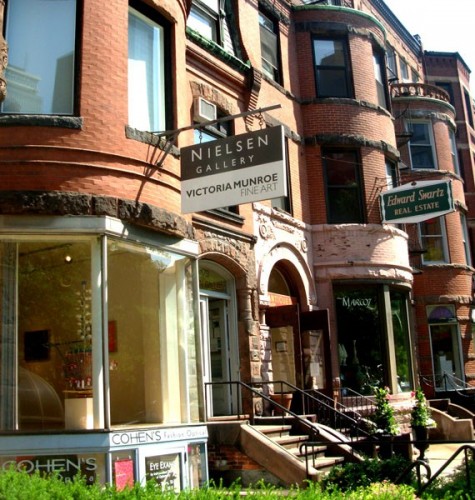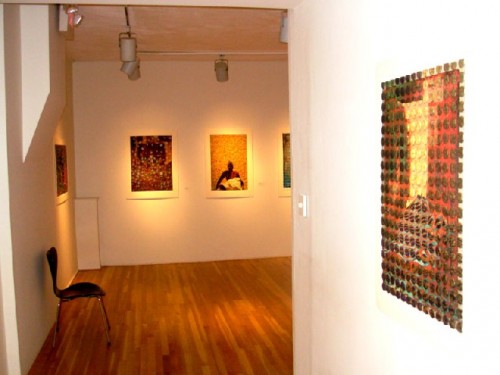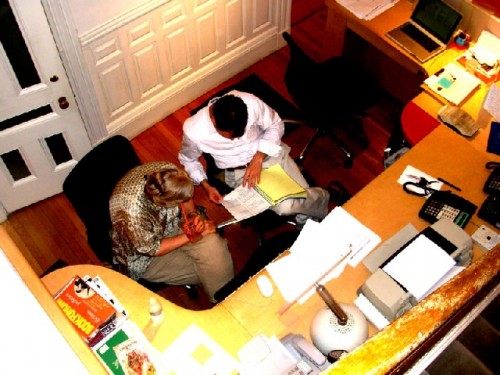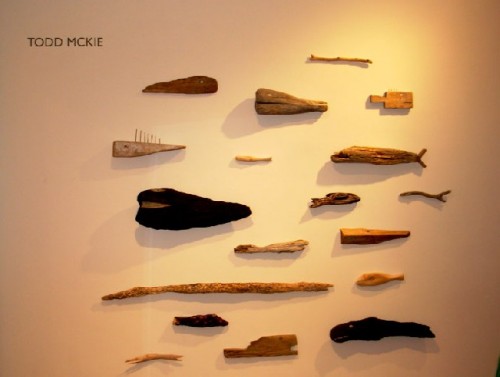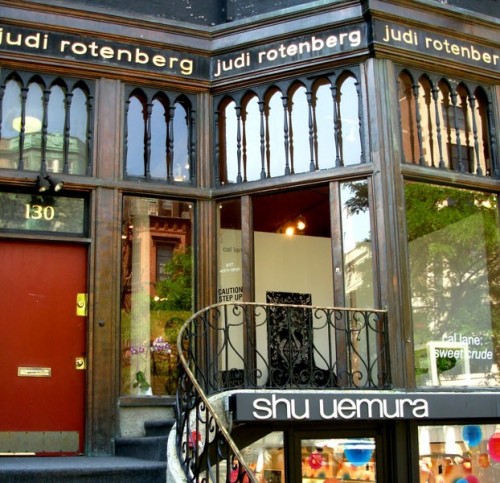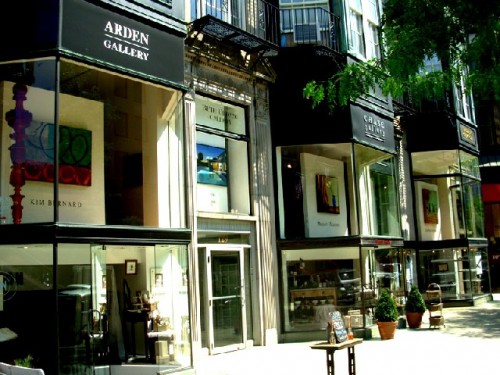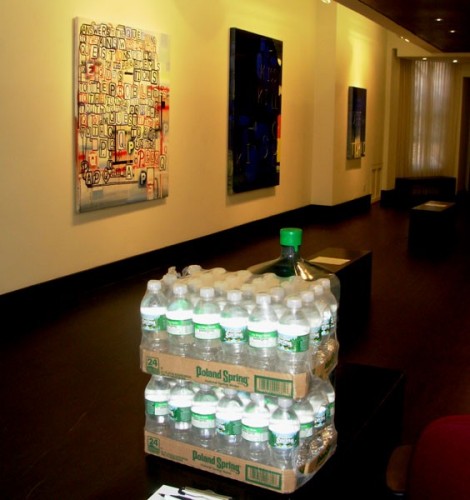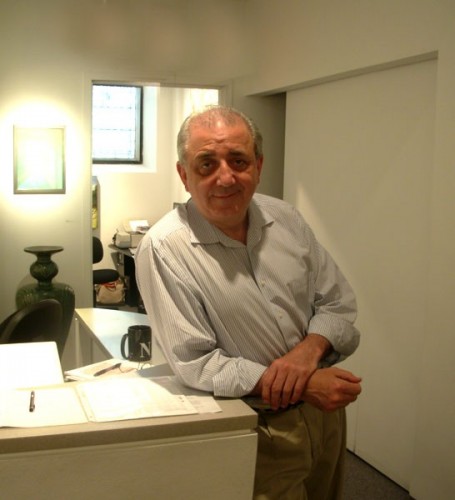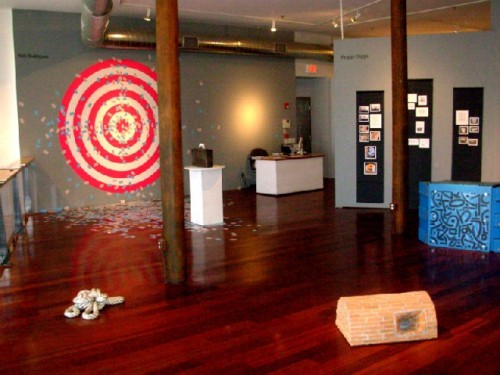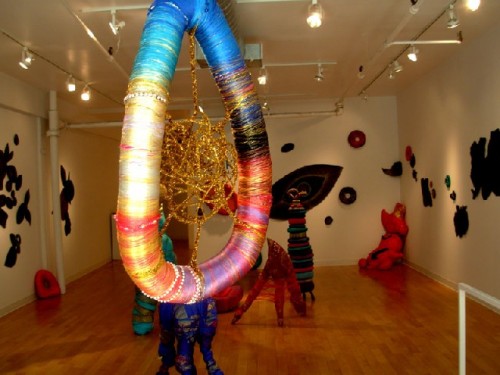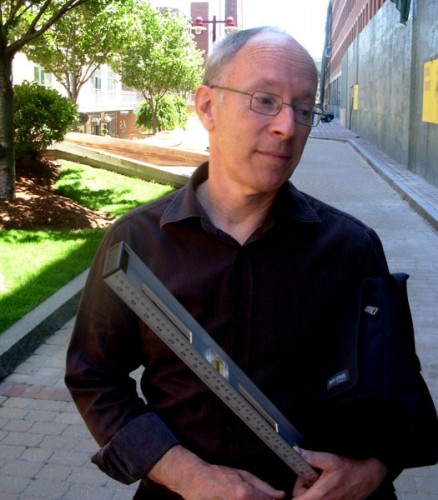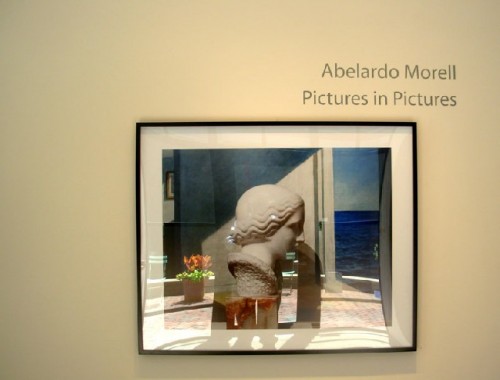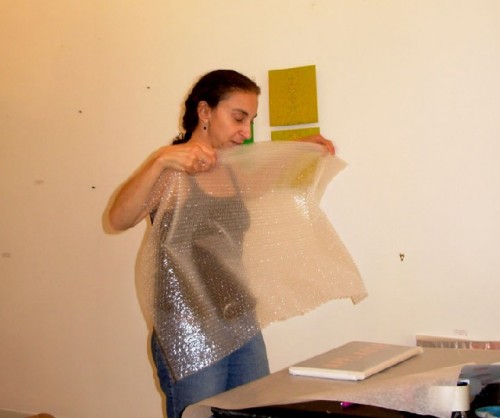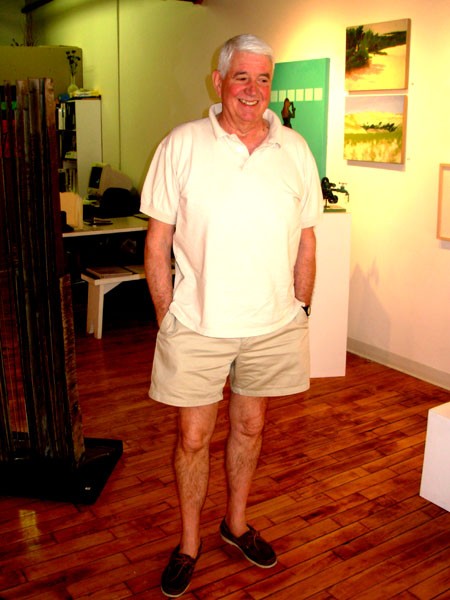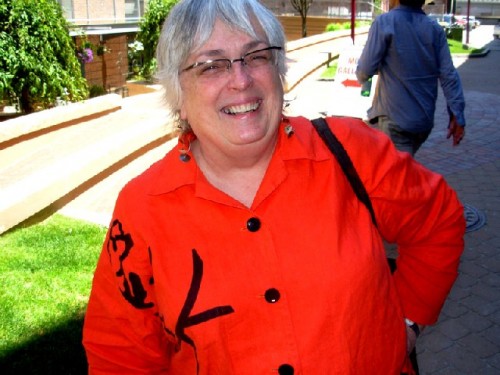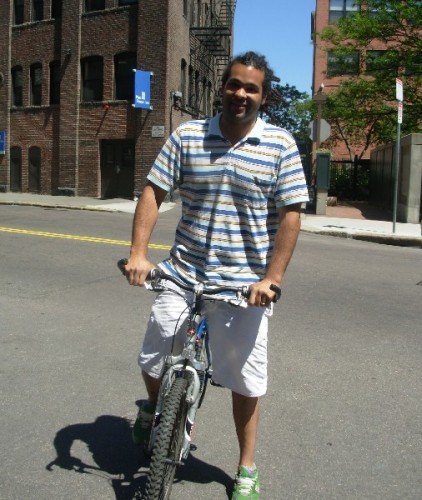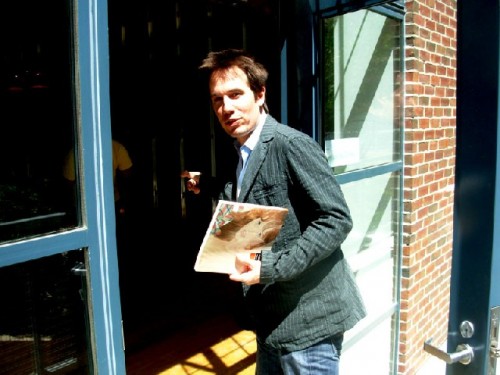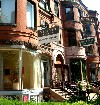Boston Galleries Shuffle the Deck
Shake Rattle and Roll on Newbury Street and SOWA
By: Charles Giuliano - Jun 17, 2008
The cover of the May issue of Art News Magazine proclaimed "The Private Art Market $25 Billion and Counting." With some 300 international biennials and as many art fairs there is an explosion of the art world.
By contrast, in an article in the current Art in America, Irving Sandler speculates that there were perhaps 100 serious New York artists during the post war era of Abstract Expressionism. During the mid 1960s, when I was living in the Lower East Side, the art galleries were confined to midtown intersecting along 57th Street and Madison Avenue. The Sunday Times published the weekly list of openings. We would clip it and gather with friends for the circuit of wine and cheese.
On any given evening you could see most of the "serious" New York artists at Max's Kansas City. During Happy Hour Mickey Ruskin would put out the free chicken wings. That, and a seventy five cent glass of wine, made an evening meal. If you hung around long enough you got to enjoy the midnight parade of Andy's factory gang into the back room under Dan Flavin's light sculpture.
Eventually, the Times stopped publishing the openings because there were just too many galleries. Today, there may be 100,000 artists in the New York area. Only the most successful can still afford Manhattan.
Cranking out studio degrees has evolved as a growth industry for colleges and universities. Art schools have evolved from awarding certificates to offering degrees just to keep up. Bottom line, there are just too many artists.
Part of what is fueling this lopsided equation is the unquenchable hunger for the rich to fill their luxury condos, villas, and warehouses with art. In a tricky economy art seems like a more stable investment than the stock market, real estate (for sure) or gold. Art is now as good if not better than gold. And you get to look at it. Well, whatever is not in storage. Among mega wealthy peers owning a Jeff Koons sculpture is way more impressive than just another, ho hum, Ferrari. Like Everyone has one of those. I recall the disdain of parking lot attendants in Palm Beach when I drove in with Mom's Taurus while shopping on Worth Avenue. But most of the art in the Palm Beach galleries was utter crap. Underneath the Helen Frankenthaler wallpaper they would prop up the Abrams coffee table book. How utterly crass.
A decade or more ago when it came to art the super rich had no taste. But now their kids have gone to art school or earned degrees in arts administration. In the past bored socialites became interior decorators but now they are private dealers or art consultants.
In this insane $25 billion private art market a lot of young artists are getting rich. They summer in the Hamptons with an au pair and a wet nurse from Tuscany. Like the infant Michelangelo their pups get to suckle on the breasts of the wife of a stone cutter from Cararra.
Despite an apparent boom in the international art market most of the action is confined to the upper stratosphere. Art News speculated that there are 100 or so galleries grossing sales in excess of $100 million annually. At the bottom of the pyramid, as has always been the case, there are dealers struggling to cover expenses. Opening an art gallery remains as risky as starting a restaurant.
It had been a year since we last walked down Newbury Street in Boston or visited the galleries in SOWA or the South End. While it was great to catch up with old friends there were also shocks and surprises. There was a mini tsunami as leases were expiring for three galleries at 14 Newbury (Miller Block, Howard Yezerski, Beth Urdang/ Judy Goldman) and on Thayer Street in the South End.
Given the current economy, now described as a recession, with oil driving inflation and fueling increasing unemployment, this is not the best time to be selling low profile regional and emerging artists. Unless you have a well established business, and a solid clientele, this is a tricky time to sign a five year lease.
But the expansion of Boston is visible and inevitable. There is massive waterfront construction near the ICA on the waterfront. Everywhere in the South End there is evidence of new condo development. All of these luxury homes and offices will inevitably acquire art. In the roller coaster economy everyone wants to catch the next wave.
Asked to comment on the greater than normal turnover of galleries Arthur Dion, of Gallery NAGA, was typically droll in observing that "The tide comes in. The tide goes out." NAGA does not travel the art fair circuit but has established a business representing a selection of leading regional artists. It is widely regarded for its leadership in the field of studio furniture. The very capable Meg White is director of the gallery. "Over the years we have established a very successful business selling work by local artists to local collectors. So I do not for a minute accept the argument that Boston has no collectors. We are exploring the possibility of doing a limited number of art fairs each year probably starting with Chicago."
Having a secure hold on turf and avoiding spikes in rent is key to survival. Nina Nielsen Gallery on Newbury Street own its building. Nielsen rents out the lower level and, in the past few years, has leased what was formerly the second floor of her operation, to Victoria Munroe. When we visited Nielsen was presenting one person shows for abstract artist Ralph Humphrey and the African American artist Mildred Howard. Nielsen represents the major British artist, John Walker, a professor at Boston University.
While Rotenberg Gallery rents space which is owned by the family. Several years ago, the gallery was taken over by Rotenberg's daughter, Abigail Ross. Gradually, Rotenberg Gallery developed an ever more progressive stable. With director, Kristen Dodge, the gallery has recruited artists who have attracted serious curatorial attention. Currently, the gallery is presenting its first show by Cal Lane. They discovered Lane, who cuts lace like patterns into metal objects such as shovels, wheel barrows, and oil drums, while visiting a New York art fair. Rotenberg artists have been featured at Mass MoCA and the Whitney Museum.
Visiting the third floor of 38 Newbury Street we were surprised to find the Miller Block Gallery moving into a space formerly occupied by Audrey Pepper. It appears that Pepper has decided to shut down. ACME Fine Art had already moved from a small space to a larger one on the same floor. They deal in the secondary market with an emphasis on historic Provincetown artists.
We talked with Robert Klein, of 38 Newbury, a nationally recognized dealer in vintage and contemporary photography. Asked for his assessment Klein responded that "We are keeping the lights on." He discussed the change in recent years that has largely eliminated the walk in retail business. There was a time "during the dot com boom" when the gallery made strong sales to business travelers. The gallery had a regular clientele of photo collectors who are now seen less frequently. He noted the transition of sales to art fairs and the internet. While he participates in select art fairs there are ever increasing expenses particularly internationally. The value of the inventory, however, is increasing at a staggering rate. He pointed out an Avedon portrait of Marilyn Monroe, on consignment, for $500,000. Not that long ago it was considered expensive at $50,000.
As always Howard Yezerski proved to be poignant, insightful, philosophical, and a tad melancholy. Being forced to vacate 14 Newbury he faced a tough decision. While he acknowledged that the art business has shifted to art fairs and the internet he's just not that kind of guy. "I'm not a wheeler dealer selling out of the back room," he said. "That's not what I do. I'm a gallerist. I put on shows. I like putting together exhibitions." Having an intimate relationship with the artists he represents, as well as fellow dealers, is very important. He referred to the breakup of their floor as the loss of "a family." Beth Urdang has relocated to the mezzanine level between Chase and Arden galleries at 129 Newbury Street. While Judy Goldman will continue as a fine art appraiser.
While he has considered all the risk and uncertainty Yezerski will reopen in September on Thayer Street in an enormous, mixed use building. The building is being developed in stages over the next few years. It is parallel to a well established gallery complex.
Years ago Yezerski started as a frame shop/ gallery in Andover. His wife, Katherine, continues to run the frame shop. Since then he has moved around with the ebb and flow of the galleries. He was part of the group on South Street and he is now vacating his second Newbury Street venue. With an engaging smile he stated that "I will have more space for less money. But I will be 71 when the lease expires. What choice do I have? It's what I'm good at."
On the following day we visited the South End. It was a bit of a hike from Copley Square and there is no easy access by public transportation. So it is far less accessible than a stroll down Newbury Street. There are parking lots but we prefer not to drive in the city.
Passing Ars Libri, the vintage art bookstore, we missed the usual, single, feisty work in the second floor picture window placed there by the eccentric, legendary, Italian born, art dealer Mario Diacono. He now appears to be retired. Mario was famous for showing just one or two very expensive works by artists like Julian Schnabel, Damian Loeb, or David Salle. He was the first major dealer to show Ellen Gallagher when she lived in Boston.
We dropped in on Boston Sculptors Gallery at 486 Harrison Avenue. Like two other SOWA cooperatives, Kingston and Bromfield, they prove to be stable and recession proof because the members share expenses. The galleries survive on dues and are not dependent on sales which tend to be less frequent than in commercial galleries. The primary mission of these galleries is to provide opportunities for artists to show their work. Because of their location in a major market, with many leading universities and art colleges, the quality of artists represented by these cooperatives is remarkable. The challenge is that artist run galleries rarely have the resources and skills involved in successful marketing and sales strategies. The artist taking a turn at sitting in the gallery, on any given day, is not inclined to aggressively sell the work to a potential client.
Walking down Thayer Street we encountered the renowned gallerist Bernard Toale. After ten years as a pioneer of the South End galleries he is stepping back and will be semi retired. "I am really looking forward to it," he said. His space will be renovated this summer and emerge as the Joseph Carroll Gallery. The newly named gallery, operated by Toale's former associate, will carry on representation of Toale's artists. Toale will occupy a smaller space as the base for projects which are yet to be fully defined.
"We have been planning this for the past year and half and I can't wait," Toale said. It frees him from the day to day management responsibilities. All told, he has been in the gallery business, starting on Newbury Street, for 16 years. Before that, he and Joe Zina owned Rugg Road which worked with artists to make paper pieces. I wrote about one of those collaborations, with John Cage (edible paper), for Art News. And I knew Toale even before that as a part of the bohemian scene of artists living on Hano Street in Allston. We go back. His partner, Joe Zina, is also stepping down as director of the Coolidge Corner Theater in Brookline.
Will you do the art fairs I asked? "Hell no," Bernie responded. "I have no inventory to sell." We asked about his plans. He appears to still be in a thinking process but described some publishing projects for his artists Ambreen Butt and David Hilliard. The last show of Toale Gallery presented the photographer Abelardo Morell who was featured on the cover of Art New England in an article by former Boston Globe critic, Christine Temin.
Descending to the lower level of Thayer Street, with its row of galleries, we encountered Randi Hopkins taking a stack of boxes to her car. She and her partner, Beth Kantrowitz, are shutting down after nine years in business. They started in Allston in a loft building and named themselves after the original occupant. There have been a lot of playful quips about those hemlines. The partners were known for representing edgy work. Randi, who writes for the Phoenix which she will continue, implied that she would have liked to keep going. "We are going out on a high," she said. They both warmly thanked me for coverage over the years. They appreciated the honest and often tough reviews. With a laugh they reminded me of trashing a show of work by a very young Zach Feuer. He didn't get very far as an artist but is now regarded as a leading New York art dealer. Apparently, my review might have helped him to make the right decision.
A few doors down Arlette Kayafas, a dealer in fine art photography, related how much she will miss Beth and Randi. Facing a lease renewal she is staying on. "I never expected to make any money," she said. "But we are committed to showing the work." She and her husband Gus are mega photo collectors who have known and worked with some of the legends in the field. It is the only life they know and they are truly loved and respected for their work and commitment.
Dropping in on Samson Projects, as usual, Camillo Alvarez was not around. But the assistant said that he had just gotten back from Basel and would be in the gallery later in the day. Actually, we frequently run into Camillo at art fairs. He treats the gallery as a kind of office while his real business is conducted internationally. Later in the afternoon we encountered him while biking to the office. We chatted briefly and he described the Basel Art Fair as a success but that he didn't see all that many Americans this time. Given the staggering increase of expenses, even at the high end, there are dramatic cutbacks. This season a lot of those super expensive European hotel rooms will be unoccupied. During our three weeks in Italy, last fall, we got clobbered by the Euro. Lots of folks are thinking twice this summer about Tuscany and Provence. Hey, come to the Berkshires.
Michael Price of MPG Contemporary is shutting down after ten years on Thayer Street. He reported losing money over the past couple of years. Price is just walking away as he doesn't have the client base or successful artists to continue as a private dealer. There was a selection of artists he enjoyed working with as his final show. By contrast, he was eager to discuss his son Seth who was included, for the second time, in the recent Whitney Biennial. The success of his son says a lot about the generation gap.
It is always fun to run into my former Boston University art history student Steve Zevitas. He is the owner of Open Studio Press which publishes the regional, juried editions of New American Painting. That enterprise has "really taken off." For a time the artists featured in the book/ magazines were show in OSP Gallery which occupied some of the office space. Zevitas is moving down stairs to what was formerly the largest space on Thayer Street the Genovese Sullivan Gallery. That pioneering South End gallery has now departed. He took us on a tour of the build out which will open as the Stephen Zevitas Gallery. The work he represents will be independent of his publications.
The globe trotting Zevitas is a real success story and a glittery aspect of the $25 billion and counting art market. Even though there are the inevitable annual closings, cutbacks and reconfigurations it is far from all gloom and doom. It remains a tricky business but, even in hard times, the high end artists and dealers are rolling in clover. It just takes nerves of steel.

